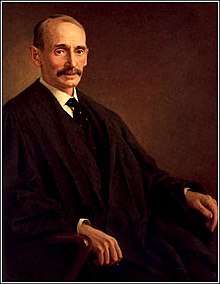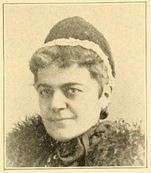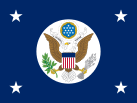William R. Day
| Will Day | |
|---|---|
 | |
| Associate Justice of the Supreme Court of the United States | |
|
In office February 23, 1903 – November 13, 1922[1] | |
| Nominated by | Theodore Roosevelt |
| Preceded by | George Shiras |
| Succeeded by | Pierce Butler |
| Judge of the United States Court of Appeals for the Sixth Circuit | |
|
In office February 28, 1899 – February 23, 1903 | |
| Nominated by | William McKinley |
| Preceded by | Seat established |
| Succeeded by | John Richards |
| 36th United States Secretary of State | |
|
In office April 28, 1898 – September 16, 1898 | |
| President | William McKinley |
| Preceded by | John Sherman |
| Succeeded by | John Hay |
| United States Assistant Secretary of State | |
|
In office May 11, 1897 – April 27, 1898 | |
| President | William McKinley |
| Preceded by | William Rockhill |
| Succeeded by | John Moore |
| Personal details | |
| Born |
William Rufus Day April 17, 1849 Ravenna, Ohio, U.S. |
| Died |
July 9, 1923 (aged 74) Mackinac Island, Michigan, U.S. |
| Political party | Republican |
| Spouse(s) | Mary Schaefer |
| Children | 4, including William and Stephen |
| Education | University of Michigan, Ann Arbor (BS) |
| Signature |
|
William Rufus Day (April 17, 1849 – July 9, 1923) was an American diplomat and jurist, who served for nineteen years as a Justice of the Supreme Court of the United States. Prior to his service on the Supreme Court, Day served as the 36th United States Secretary of State during the administration of William McKinley.
Life and politics

Day was born in Ravenna, Ohio, son of Luther Day of the Ohio Supreme Court. He graduated from the University of Michigan in 1870, spent a year studying law with attorney and judge George F. Robinson, and then a year at the University of Michigan Law School. He was admitted to the bar in 1872 and settled in Canton, Ohio, where he began practicing law in partnership with William A. Lynch. For twenty-five years, Day worked as a criminal defense and corporate lawyer in the growing industrial town while participating in Republican politics.
During these years, Day became a good friend of William McKinley. Day became McKinley's legal and political adviser during McKinley's candidacies for the Congress, the governorship of Ohio, and the presidency of the United States. After he won the presidency, McKinley appointed Day to be Assistant Secretary of State under Secretary of State John Sherman. Sherman was considered to be ineffective because of declining health and failing memory, and in 1898, President McKinley replaced Sherman with Day.
Five months later, Day vacated his cabinet position to helm the United States Peace Commission formed to negotiate an end to the Spanish–American War with Spain.[2] After the Spanish–American War was declared, Day had argued that the Spanish colonies, other than Cuba, should be returned to Spain, contrary to McKinley's decision that the United States should take over from Spain control of the Philippines, Puerto Rico, and Guam. Day, however, negotiated peace with Spain on McKinley's harsher terms. His final diplomatic effort was to lead the United States Peace Commission into Paris, France and sign the Treaty of Paris ending the war.
On February 25, 1899, following Day's return from Europe, McKinley nominated Day to a new seat, on the United States Court of Appeals for the Sixth Circuit, created by 30 Stat. 803. The Circuit included Day's home state of Ohio. Day was confirmed by the United States Senate very quickly, on February 28, 1899, and received commission the same day. His position as head of the state department was filled by John Hay.
President McKinley was assassinated in September 1901 and Vice President Theodore Roosevelt took his place. On February 19, 1903, Roosevelt nominated Day as an Associate Justice of the U.S. Supreme Court, to a seat vacated by George Shiras, Jr. The Senate confirmed the nomination on February 23, 1903, and Day received his commission the same day, thereafter taking his new position on March 2, 1903.
Day wrote 439 opinions during his tenure on the court, of which only 18 were dissents. He distrusted large corporations and voted with antitrust majorities throughout his time on the court. He sided with the government in the Standard Oil, American Tobacco, and Union Pacific cases in 1911 and 1912 and again in the Southern Pacific case in 1922.
He was an avid baseball fan.[3] He is recorded as asking his clerk for "regular updates" during the bench hearing of Standard Sanitary Mfg. Co. v. United States about the final game of the 1912 World Series.[4]
Day retired from the court on November 13, 1922, and briefly served as an Umpire of the Mixed Claims Commission to Adjudicate War Claims against Germany. He died in July of the following year on Mackinac Island in Michigan, aged 74. He is buried at West Lawn Cemetery in Canton, Ohio.
Important opinions authored by Day
- Ware & Leland v. Mobile County, 209 U.S. 405 (1908)--held that contracts for the sales of cotton for future delivery that do not oblige interstate shipments are not subjects of interstate commerce
- Bobbs-Merrill Co. v. Straus, 210 U.S. 339 (1908)--helped establish "first-sale doctrine" in United States copyright law
- Muskrat v. United States, 219 U.S. 346 (1911)--held that there must be an actual controversy between parties for the Federal courts to have jurisdiction
- Bauer & Cie. v. O'Donnell, 229 U.S. 1 (1913)--held that patent rights could not be extended by the holder by means of a licensing agreement.
- Weeks v. United States, 232 U.S. 383 (1914)--held that exclusionary rule is applicable to the federal government for violations of the Fourth Amendment.
- Buchanan v. Warley, 245 U.S. 60 (1917)--held that municipal ordinances segregating neighborhoods were unconstitutional
- Hammer v. Dagenhart, 247 U.S. 251 (1918)-- held that laws regulating child labor are beyond the scope of Congress's constitutional power under the commerce clause
References
- ↑ "Federal Judicial Center: William R. Day". 2009-12-11. Retrieved 2009-12-11.
- ↑ William Rufus Day
- ↑ Ross E. Davies. "A Crank on the Court: The Passion of Justice William R. Day". Retrieved 2018-06-29.
- ↑ The First Fall Classic (2009), ISBN 978-0-385-52624-1, Mike Vaccaro, page 233
- William Rufus Day at the Biographical Directory of Federal Judges, a public domain publication of the Federal Judicial Center.
External links
| Wikimedia Commons has media related to William Rufus Day. |
- William R. Day at Find a Grave
- William R. Day at The Political Graveyard
- William R. Day biography at The Ohio Judicial Court
- William R. Day biography at Michael Ariens
- William R. Day biography at The United States Court of Appeals for the Sixth Circuit
- William R. Day biography at The Raven Hall of Fame
- William R. Day biography at The United States State Department
- William R. Day biography at The Hall of the Secretaries of State
| Political offices | ||
|---|---|---|
| Preceded by William Rockhill |
United States Assistant Secretary of State 1897–1898 |
Succeeded by John Moore |
| Preceded by John Sherman |
United States Secretary of State 1898 |
Succeeded by John Hay |
| Legal offices | ||
| New seat | Judge of the United States Court of Appeals for the Sixth Circuit 1899–1903 |
Succeeded by John Richards |
| Preceded by George Shiras |
Associate Justice of the Supreme Court of the United States 1903–1922 |
Succeeded by Pierce Butler |
|
 | ||||||||||||||||||||||||||||||||||||

